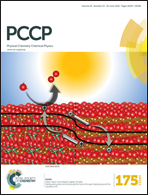NMR absolute shielding scale and nuclear magnetic dipole moment of 207Pb
Abstract
An absolute shielding scale is proposed for 207Pb nuclear magnetic resonance (NMR) spectroscopy. It is based on ab initio calculations performed on an isolated tetramethyllead Pb(CH3)4 molecule and the assignment of the experimental resonance frequency from the gas-phase NMR spectra of Pb(CH3)4, extrapolated to zero density of the buffer gas to obtain the result for an isolated molecule. The computed 207Pb shielding constant is 10 790 ppm for the isolated molecule, leading to a shielding of 10799.7 ppm for liquid Pb(CH3)4 which is the accepted reference standard for 207Pb NMR spectra. The new experimental and theoretical data are used to determine μ(207Pb), the nuclear magnetic dipole moment of 207Pb, by applying the standard relationship between NMR frequencies, shielding constants and nuclear moments of two nuclei in the same external magnetic field. Using the gas-phase 207Pb and (reference) proton results and the theoretical value of the Pb shielding in Pb(CH3)4, we find μ(207Pb) = 0.59064 μN. The analysis of new experimental and theoretical data obtained for the Pb2+ ion in water solutions provides similar values of μ(207Pb), in the range of 0.59000–0.59131 μN.


 Please wait while we load your content...
Please wait while we load your content...